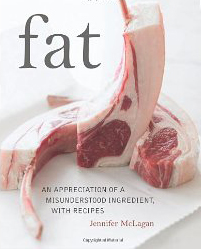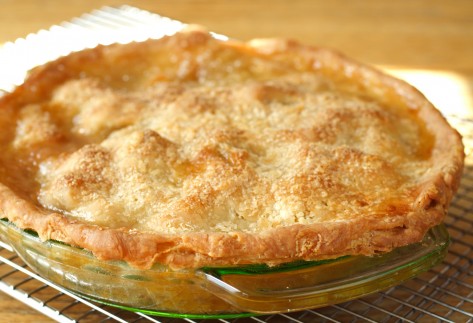Fat Words
. . . reading about one of nature’s best flavor enhancers

FAT
An Appreciation of a Misunderstood Ingredient, with Recipes
By Jennifer McLagan
Ten Speed Press
240 pp. $32.50
When DCCC members picked Fat this spring, I decided to make The Food of Franceby Waverly Root my companion read. This beautiful book—its is spine embellished with golden fleur-de-lis—is organized by butter, fat, and oil.
I got as far as the second page, where I was stopped in my tracks by a sentence so concise and so contemporaneous, even though the book was published in 1958:
“. . . .food is a function of the soil, for which reason every country has the food naturally fit for it.”
Or, said another way by Dan Barber, chef/owner of Blue Hill (Manhattan and Hudson Valley locations) in the current Wall Street Journal magazine:
“[True sustainability is] about cuisine that’s evolved out of what the land is telling you it wants to grow.”
In her book Fat, Jennifer McLagan reminds us of this natural truth as it relates to animal fats or the products of animals. Not only are the products and fat of animals raised on the land more flavorful, they’re also more healthy. Did you know, for example, that butter from grass-fed cows has more omega-3 fatty acids and CLA, or conjugated linoleic acid? The latter has a range of health benefits including, according to McLagan, the ability to fight weight gain.
Unlike The Food of France, I read nearly every word in Fat, subtitled “An Appreciation of a Misunderstood Ingredient, with Recipes.” True to the title of her book, McLagan disabuses our modern day prejudices against and misconceptions about fat.

Suet and butter crust from FAT
When you read in a headnote that McLagan picked her wedding date because of a pastry—she chose St. Honore’s Day in honor of the Saint Honore pastry—you know there could be no better woman for the job. A good writer, she blends a strong personal voice with faultless research and interesting anecdotes, making her book an authoritative resource that touches on nutrition, science, farming, history, culture, and art as well as a pleasure to read.
Fat is comprised of four chapters: butter, pork fat, poultry fat, and beef and lamb fats. In each McLagan tells the fascinating story of the fat, including the hard nutritional facts, and gives invaluable instruction on handling the fats in the kitchen. In the butter chapter you will learn how to turn cream into butter, in the pork chapter, how to render lard, and so on.
The recipes using the five fats featured in the book range from the familiar, like spaghetti carbonara and Boston-style baked beans, to the unfamiliar, like double butter salad, a salad of tender lettuce dressed with a warm butter and vinegar dressing, to the simply elegant, like prosciutto-wrapped halibut with sage butter.
Some members felt the recipe instructions could have been clearer or more detailed in some cases—particularly when the dish being prepared was new to them (there are a lot of potential “newbies” in the book, depending on how experienced or adventurous a cook you are). This handful of recipes may take a bit of experimentation. The result, a collaboration between you and McLagan, will be all the more satisfying for it.
Case in point: Wendy, a friend and DCCC member, prepared Slow-Roasted Pork Belly with Fennel and Rosemary from the book. McLagan’s recipe was Wendy’s introduction to cooking pork belly and the first time she made it was not a success. Wendy went by the internal temperature (160°F) of the meat rather than the time. The result? Belly safe to eat, certainly, but not melt-in-your mouth tender.
After experimenting with the roasting time and temperature the belly was perfect, and the flavoring and seasoning, including the sauce, all McLagan, was divine. Served with kale, as McLagan suggests, we all agreed it was one of the best meals we’d had all year.
Here is what Wendy did: She reduced the time of McLagan’s initial high-heat roast from 30 to 20 minutes, then cooked the belly for the full amount of time (2 to 2½ hours), ignoring internal temps, at 300°F rather than 325°F as McLagan suggests. She finished it under the broiler as McLagan recommends. The second time around the fat became golden and unctuous and at the same time more crispy, and the meat more tender. Keep in mind that oven temperatures may vary a bit, and that the thickness of the belly will have an affect on the results. Wendy used a thick piece, about 1-inch thick, as McLagan recommends.

Breton Butter Cake
Many recipes came out perfectly: the Burnt Butter Biscuits, a cookie to you and me; Buttered Parsnips and Rutabega, a hearty winter puree flavored with cumin and orange juice; Roast Beef with All the Trimmings, including Yorkshire Pudding; and Kouign Amann, or Breton butter cake. I was especially excited to find the latter in the book. Many years ago I ordered it at Prune, a restaurant in New York. It was served with a glass of Muscat, which I drizzled over top. Perhaps a uncouth gesture (any French people out there to let me know if that is done in France?), but a Muscat-laced bite of this delicate flavored but toothsome cake is one of the best desserts in the world. If you perfect this cake, there really is no reason to learn to make any other dessert—if you serve it with a bottle of Muscat.
At the end of the day, DCCC members are happy to have Fat on their bookshelves: It’s a fantastic read and it’s gotten each of us to do something we’d never done previously—whether making butter, rendering lard, grating suet for pastry making, or roasting pork belly. And that is one of the main aims of our cookbook club.
